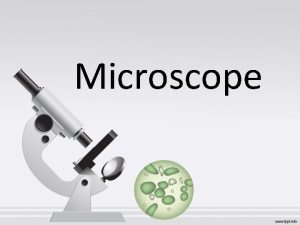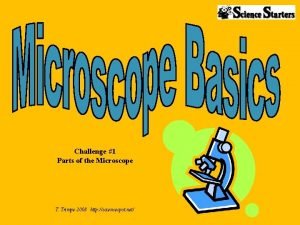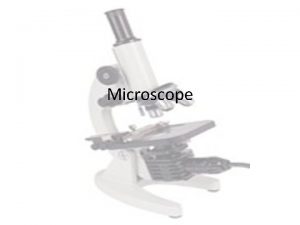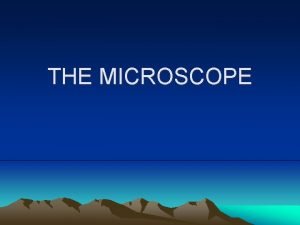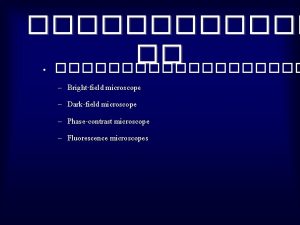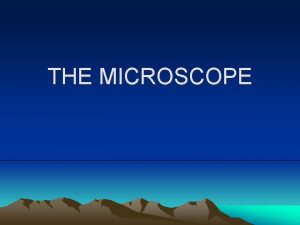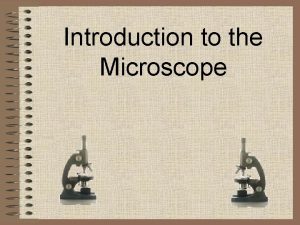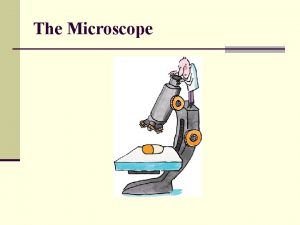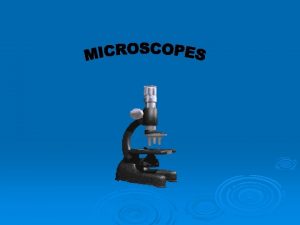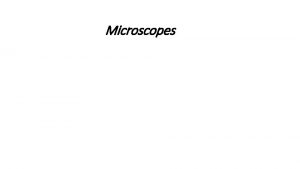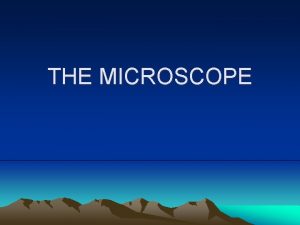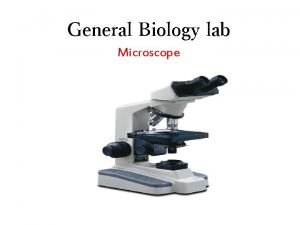The Microscope MICROSCOPE An instrument for making an














- Slides: 14

The Microscope • MICROSCOPE: An instrument for making an enlarged image of an object which is too tiny to be seen by the “naked” eye. • LENS: a piece of glass or plastic that bends light rays causing them to come together or move away from each other to form an image.

A little Bit of HISTORY • Late 1500’s – first light microscope • Mid 1600’s – Leeuwenhoek – simple microscope “Father of Microscopy” • 1665 – Robert Hooke saw cells with compound microscope • 1800’s – Cell theory • 1930’s – Electron microscope

Brief History • Mid 1500 s –First microscope. – A Dutch reading glasses maker put 2 magnifying glasses together in a tube to get a larger image than either lens alone. • Mid 1600 s – Anton van Leeuwenhoek – Improved the microscope; magnified objects 270 times their original size – Using his microscopes, he was the first to observe and describe single celled organisms, which he originally referred to as animalcules (we now refer to them as microorganisms!).

Types of Microscopes • Simple microscope: Use ONE lens. – Example: Magnifying glass. • Compound light microscope--named because they use two or more lenses to magnify objects. – Highest possible magnification is 1, 000 X – We use a microscope of 400 x • Electron Microscope --Do not use lenses to direct light; they use electrons (negatively charged electrical particles) to magnify objects up to 2, 000 X!!! – allow scientists to view things too small to be seen with a light microscope. – Used to observe atoms and molecules

Electron Microscope Compound Microscope

PARTS of a Microscope • Eyepiece Lens: the lens at the top that you look through. • Body Tube: Connects the eyepiece to the objective lenses. • Objective Lenses: Usually you will find 3 objective lenses on a microscope. They almost always consist of 4 X, 10 X, 40 X - magnify objects/specimens • Nosepiece: This is the part that holds the objective lenses and can be rotated to change power. • Base: The bottom of the microscope, used for support. • Arm: Supports the tube and connects it to the base

• Light source: found near the base of the microscope; makes the specimen easier to see. • Stage: The flat platform where you place your slides. • Stage clips: found on the stage; hold the slides in place. • Diaphragm: rotating disk under the stage; different sized holes vary the intensity and size of light that is projected upward into the slide. • Coarse adjustment knob: large, round knob on the side of the microscope used for focusing the specimen; it moves the stage up and down. • Fine adjustment knob: small, round knob on the side of the microscope used to fine-tune the focus of your specimen after using the coarse adjustment knob.

Magnification and Field of View • Magnification: is the process of enlarging something only in appearance, not in physical size • Total Magnification: power of eyepiece X power of objective lens • Example: What is the total magnification if the eyepiece has a power of 10 x and the objective lens has a power of 4 x?

FIELD OF VIEW • Field of View: The area of the slide that you see when you look through a microscope; it is the circle of light. • When viewing a small organism through the microscope, it’s usually necessary to have some idea of its size. Therefore, you need to have some way of estimating the size.

Calculating Total Magnification • IT’S EASY! • Take the power of the objective (4 X, 10 X, 40 x) and multiply by the power of the eyepiece (usually 10 X). • calculating total mag

Field of View • When someone is standing near a doorway, you can estimate their height by comparing them to the doorway. – Example: If the “doorway is 10 units, how high is the stick person? • You can estimate an organism’s length the same way, by comparing it to the field of view that you are using.

OK That’s easy, but how do I find the diameter of the field of view?

• Now, millimeters is a nice metric unit, but when we use a MICROscope we tend to use MICROmeters. • 1 mm = 1000 µ • To convert from millimeters to micrometers, move the decimal 3 places to the right. Ex. 1. 3 mm = 1300 micrometers (µ). • YOU TRY: 1) 2 mm = ____µ 2) 5. 2 mm = _______µ 3) 1. 6 mm = ____µ 4) 3 mm = ____µ

Field of view for higher powers • Total magnification on low power • ---------------------- • Total magnification on other power
 Passive and active instruments
Passive and active instruments Which instruments
Which instruments A microscope is an instrument that
A microscope is an instrument that A microscope is an instrument that
A microscope is an instrument that Is making inference simply making a guess
Is making inference simply making a guess War making and state making as organized crime summary
War making and state making as organized crime summary Microscope mania compound light microscope
Microscope mania compound light microscope Light microscope vs electron microscope
Light microscope vs electron microscope Nationell inriktning för artificiell intelligens
Nationell inriktning för artificiell intelligens Bästa kameran för astrofoto
Bästa kameran för astrofoto Tillitsbaserad ledning
Tillitsbaserad ledning Bat mitza
Bat mitza Klassens frånvaro rim
Klassens frånvaro rim Nyckelkompetenser för livslångt lärande
Nyckelkompetenser för livslångt lärande Mästare lärling modell
Mästare lärling modell



